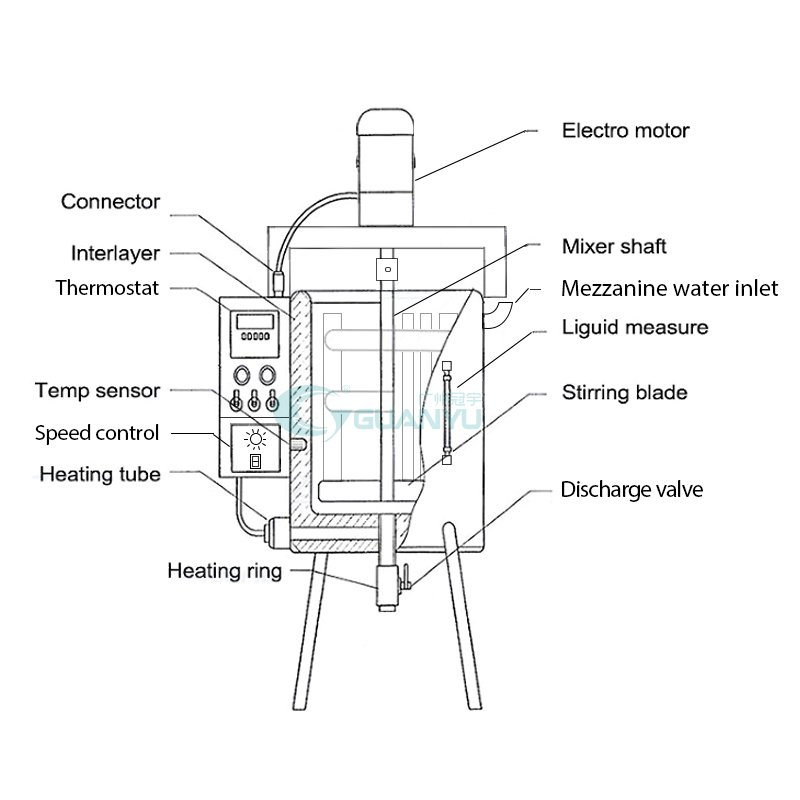ลิปสติกเป็นผลิตภัณฑ์เสริมความงามที่มีประวัติยาวนานนับพันปี, แต่การผลิตสมัยใหม่ทำให้เข้าถึงได้, ซื้อได้, และหลากหลาย. ด้วยสีสันอันสดใส, พื้นผิวเรียบ, และการตกแต่งที่แตกต่างกัน, การผลิตลิปสติกผสมผสานศิลปะและวิทยาศาสตร์เข้าด้วยกัน. ในบทความนี้, เราจะเจาะลึกกระบวนการผลิตลิปสติกอันน่าทึ่ง, พูดคุยเกี่ยวกับส่วนผสม, อุปกรณ์ที่เกี่ยวข้อง, และขั้นตอนที่แต่ละผลิตภัณฑ์ต้องผ่านก่อนที่จะถึงมือผู้บริโภค.

ส่วนประกอบสำคัญในการผลิตลิปสติก
เสน่ห์ของลิปสติกอยู่ที่สูตร. แบรนด์ต่างๆ ใช้ส่วนผสมที่แตกต่างกันเพื่อให้ได้เนื้อสัมผัสที่เป็นเอกลักษณ์, สี, และเสร็จสิ้น, แต่มีส่วนผสมสำคัญบางอย่างที่พบในลิปสติกส่วนใหญ่:
- แว็กซ์: แว็กซ์ช่วยให้ลิปสติกมีโครงสร้างและความแข็ง, ช่วยให้สามารถคงรูปทรงไว้ในหลอดได้แต่ยังคงความนุ่มพอที่จะทาได้. ขี้ผึ้งที่ใช้กันทั่วไป ได้แก่ ขี้ผึ้ง, แคนเดลิล่า อะไรสักอย่าง, และคาร์นัวบาแว๊กซ์.
- น้ำมัน: น้ำมันช่วยให้ลิปสติกมีเนื้อครีม, ทำให้ง่ายต่อการเหินข้ามริมฝีปาก. น้ำมันยอดนิยมบางชนิดที่ใช้ในการผลิตลิปสติกคือน้ำมันละหุ่ง, น้ำมันโจโจ้บา, และน้ำมันมะกอก. อัตราส่วนน้ำมันต่อแว็กซ์เป็นกุญแจสำคัญในการพิจารณาความสม่ำเสมอของลิปสติก.
- เม็ดสี: เม็ดสีให้สีและเป็นธรรมชาติ (เช่น เหล็กออกไซด์) หรือสังเคราะห์. การเลือกและปริมาณเม็ดสีสามารถกำหนดได้ไม่เพียงแต่สีเท่านั้น แต่ยังรวมถึงความทึบและความเข้มของลิปสติกด้วย.
- สารทำให้ผิวนวลและมอยเจอร์ไรเซอร์: ส่วนผสมเช่นเชียบัตเตอร์, เนยโกโก้, และมีการเพิ่มลาโนลินเพื่อให้ริมฝีปากชุ่มชื้น. ส่วนผสมเหล่านี้ช่วยปรับปรุงความรู้สึกของลิปสติกบนริมฝีปากและช่วยให้ลิปสติกมีอายุยืนยาวขึ้น.
- สารกันบูดและความคงตัว: เพื่อยืดอายุการเก็บของผลิตภัณฑ์, มีการเติมสารกันบูดเพื่อป้องกันการเจริญเติบโตของแบคทีเรีย. สารคงตัวช่วยป้องกันไม่ให้ส่วนผสมแยกออกจากกัน, โดยเฉพาะในสภาพอากาศที่หลากหลาย.
- น้ำหอมและรสชาติ: แม้ว่าจะเป็นทางเลือกก็ตาม, ลิปสติกจำนวนมากมีทั้งน้ำหอมและรสชาติเพื่อปรับปรุงประสบการณ์ผู้ใช้โดยรวม. วานิลลาและดอกกุหลาบเป็นตัวเลือกยอดนิยม.
กระบวนการผลิตลิปสติก
กระบวนการทำลิปสติกนั้นมีระเบียบวิธี, เกี่ยวข้องกับหลายขั้นตอนเพื่อให้แน่ใจว่าผลิตภัณฑ์ขั้นสุดท้ายมีสีที่ถูกต้อง, เนื้อสัมผัส, และความสม่ำเสมอ. ด้านล่างนี้คือขั้นตอนสำคัญที่เกี่ยวข้องกับการผลิตลิปสติก:
1. การหลอมและการผสม
กระบวนการผลิตเริ่มต้นด้วยการหลอมขี้ผึ้งและน้ำมัน. ส่วนผสมเหล่านี้จะถูกเติมลงใน เครื่องทำลิปสติก—ถังผสมที่ควบคุมอุณหภูมิอย่างแม่นยำเพื่อละลายขี้ผึ้งโดยไม่ทำให้ไหม้. ขี้ผึ้ง, น้ำมัน, และสารทำให้ผิวนวลจะถูกให้ความร้อนประมาณ 80°C (175°F) จนกลายเป็นของเหลวหมด.
เครื่องจักรผลิตลิปสติกมักจะมีกลไกการกวนแบบอัตโนมัติเพื่อให้แน่ใจว่าการผสมจะสม่ำเสมอ. ช่วยป้องกันการจับตัวเป็นก้อนและช่วยปั่นส่วนผสมได้อย่างราบรื่น. เครื่องจักรที่ทันสมัยมีความแม่นยำสูง, ช่วยให้ผู้ผลิตสามารถทำซ้ำความสอดคล้องเดียวกันในแบตช์ขนาดใหญ่ได้.


2. การเติมเม็ดสีและการผสม
เมื่อส่วนผสมของแว็กซ์และน้ำมันละลายและผสมแล้ว, ถึงเวลาเพิ่มเม็ดสีแล้ว. เม็ดสีมักอยู่ในรูปผงและต้องมีการผสมอย่างระมัดระวังเพื่อให้แน่ใจว่าสีจะกระจายตัวอย่างสม่ำเสมอ. เครื่องผสมแบบแรงเฉือนสูงหรือโฮโมจีไนเซอร์ใช้เพื่อสลายอนุภาคเม็ดสีและรวมเข้ากับส่วนผสมของขี้ผึ้งและน้ำมัน. ขั้นตอนนี้มีความสำคัญอย่างยิ่งต่อการบรรลุผลอย่างราบรื่น, ให้สีสม่ำเสมอด้วยความเข้มที่เหมาะสม.
ในการตั้งค่าอัตโนมัติ, เครื่องสามารถวัดและเพิ่มเม็ดสีได้อย่างแม่นยำ, ช่วยให้สามารถสร้างเฉดสีที่สม่ำเสมอทุกครั้ง. นี่เป็นสิ่งสำคัญอย่างยิ่งสำหรับการผลิตจำนวนมาก, โดยที่แบรนด์จำเป็นต้องรักษาสีที่ตรงกันสำหรับลิปสติกทุกเส้นในกลุ่มผลิตภัณฑ์เฉพาะ.
3. ความประณีตและการทำให้เป็นเนื้อเดียวกัน
เพื่อลิปสติกคุณภาพสูง, จำเป็นต้องกลั่นส่วนผสมเพิ่มเติมเพื่อกำจัดก้อนที่เหลือหรืออนุภาคเม็ดสีที่ไม่สม่ำเสมอ. ขั้นตอนนี้มักเกี่ยวข้องกับก โรงสีสามม้วน หรือโฮโมจีไนเซอร์. การผสมเม็ดสีจะถูกส่งผ่านชุดลูกกลิ้ง, ซึ่งบดให้ละเอียดสม่ำเสมอเป็นพิเศษ. กระบวนการนี้ช่วยให้เกิดความราบรื่น, เนื้อสัมผัสหรูหรา, จำเป็นสำหรับผลิตภัณฑ์ลิปสติกระดับพรีเมี่ยม.
ส่วนผสมที่กลั่นแล้วจะถูกถ่ายโอนไปยังถังทำความเย็น, โดยที่มันเริ่มเข้าสู่สถานะกึ่งของแข็ง, เตรียมสำหรับการปั้น.
4. การปั้นและการขึ้นรูป
หลังจากปรับแต่งแล้ว, ส่วนผสมลิปสติกโทนอุ่นพร้อมสำหรับการปั้นแล้ว. แม่พิมพ์ลิปสติกมักจะอยู่ในรูปแบบโลหะที่มีรูปร่างเหมือนกระสุนลิปสติกแบบดั้งเดิม. ส่วนผสมกึ่งแข็งจะถูกเทลงในแม่พิมพ์เหล่านี้ และปล่อยให้เย็นจนแข็งตัว.
ในโรงงานสมัยใหม่, เครื่องจักรทำให้กระบวนการนี้เป็นไปโดยอัตโนมัติ, ช่วยให้สามารถขึ้นรูปได้ในปริมาณมากอย่างรวดเร็ว. เครื่องจักรอัตโนมัติช่วยให้แน่ใจว่ามีการเทลิปสติกในปริมาณที่เหมาะสมลงในแม่พิมพ์แต่ละชิ้น, ช่วยป้องกันการสูญเสียและรับประกันรูปร่างและขนาดที่สม่ำเสมอ.
5. การระบายความร้อนและการตั้งค่า
เมื่ออยู่ในแม่พิมพ์, ลิปสติกต้องเย็นลงเพื่อให้เซ็ตตัวได้อย่างเหมาะสม. เครื่องจักรที่ติดตั้งก ระบบทำความเย็น ช่วยเร่งกระบวนการนี้ให้เร็วขึ้น. ในการตั้งค่าเชิงพาณิชย์, น้ำเย็นหรืออากาศไหลเวียนรอบๆ แม่พิมพ์เพื่อเร่งการทำความเย็น, ดังนั้นลิปสติกจึงแข็งตัวสม่ำเสมอและรวดเร็ว.
ขั้นตอนการทำความเย็นนี้มีความสำคัญอย่างยิ่งต่อการรักษารูปร่างของลิปสติกและป้องกันการเสียรูป. การระบายความร้อนอย่างรวดเร็วมีประโยชน์อย่างยิ่งในสภาพแวดล้อมการผลิตที่มีความต้องการสูงซึ่งประสิทธิภาพเป็นสิ่งสำคัญ.
6. เผาและขัดเงา
หลังจากที่ลิปสติกเซ็ตตัวเต็มที่แล้ว, มันผ่านกระบวนการที่เรียกว่า "ไฟ" ขั้นตอนนี้เกี่ยวข้องกับการทาลิปสติกภายใต้เปลวไฟหรือองค์ประกอบความร้อนเพื่อลบข้อบกพร่องของพื้นผิวและสร้างพื้นผิวมันวาว. Flaming ช่วยให้ชั้นนอกของลิปสติกเรียบเนียนขึ้น, ทำให้ดูเป็นมืออาชีพ.
เครื่องจักรที่ติดตั้งเครื่องมือเผาที่แม่นยำช่วยให้ผู้ผลิตมีเครื่องแบบเดียวกัน, ขัดเงา. ขั้นตอนนี้มักจะเป็นแบบอัตโนมัติในโรงงานที่มีปริมาณมากเพื่อปรับปรุงกระบวนการ.
7. บรรจุภัณฑ์
ขั้นตอนสุดท้ายในการผลิตลิปสติกคือบรรจุภัณฑ์. เมื่อเผาและขัดเงาแล้ว, กระสุนลิปสติกถูกใส่เข้าไปในปลอก. เครื่องจักรอัตโนมัติสามารถจัดการกระบวนการหุ้มด้วยความเร็วและแม่นยำ, ตรวจสอบให้แน่ใจว่าลิปสติกแต่ละอันถูกวางอย่างแน่นหนาในหลอดโดยไม่มีการปนเปื้อน.
หลังจากปลอก, ลิปสติกแต่ละอันผ่านการตรวจสอบคุณภาพเพื่อให้แน่ใจว่าเป็นไปตามมาตรฐานของแบรนด์. พอเคลียร์ได้แล้ว, สินค้าถูกปิดผนึก, ติดป้ายกำกับ, และเตรียมจำหน่าย.
ประเภทของเครื่องผลิตลิปสติก
การผลิตลิปสติกต้องใช้อุปกรณ์หลายประเภท, แต่ละคนทำหน้าที่เฉพาะเจาะจง:
- เครื่องหลอมและผสม: จำเป็นสำหรับการผสมแว็กซ์และน้ำมันในช่วงแรก, เครื่องจักรเหล่านี้มีการควบคุมอุณหภูมิที่แม่นยำและความสามารถในการผสมแรงเฉือนสูงเพื่อให้มั่นใจถึงความสม่ำเสมอ.
- เครื่องผสมแรงเฉือนสูงและโฮโมจีไนเซอร์: เครื่องจักรเหล่านี้ช่วยกระจายเม็ดสีและสลายอนุภาคเพื่อให้สีเรียบเนียน.
- เครื่องปั้นลิปสติก: เครื่องปั้นทำให้กระบวนการเทและเซ็ตลิปสติกเป็นแบบอัตโนมัติ, เร่งการผลิตและรับรองความสม่ำเสมอ.
- เครื่องเผาและตกแต่งขั้นสุดท้าย: เครื่องจักรเหล่านี้ช่วยให้ลิปสติกมีความเงางาม, สร้างความเรียบเนียน, พื้นผิวไร้ที่ติ.
- เครื่องบรรจุภัณฑ์อัตโนมัติ: ออกแบบมาเพื่อรองรับการผลิตปริมาณมาก, เครื่องเหล่านี้บรรจุลิปสติกได้อย่างรวดเร็วและถูกสุขลักษณะ, รักษามาตรฐานคุณภาพ.


ประโยชน์ของการใช้เครื่องทำลิปสติก
การลงทุนในอุปกรณ์การผลิตลิปสติกแบบพิเศษมอบข้อได้เปรียบที่สำคัญสำหรับผู้ผลิตเครื่องสำอาง:
- ความสม่ำเสมอ: เครื่องจักรอัตโนมัติช่วยผลิตผลิตภัณฑ์ที่สม่ำเสมอด้วยการจับคู่สีและพื้นผิวที่แม่นยำ, ทำให้มั่นใจว่าแต่ละชุดเป็นไปตามมาตรฐานคุณภาพของแบรนด์.
- ประสิทธิภาพ: เครื่องจักรสามารถรองรับปริมาณมากและงานซ้ำๆ ได้, ลดเวลาในการผลิตและตอบสนองความต้องการของตลาดที่สูง.
- สุขอนามัยและความปลอดภัย: เครื่องจักรช่วยลดการสัมผัสระหว่างมนุษย์กับวัตถุดิบ, รักษาความสะอาดที่จำเป็นสำหรับผลิตภัณฑ์เครื่องสำอาง.
- ประหยัดต้นทุน: แม้ว่าจะมีการลงทุนในอุปกรณ์เบื้องต้นก็ตาม, ต้นทุนการผลิตโดยรวมลดลงเนื่องจากประสิทธิภาพที่เพิ่มขึ้นและต้นทุนแรงงานลดลง.
- ความสามารถในการขยายขนาด: เครื่องจักรในการผลิตช่วยให้แบรนด์ต่างๆ สามารถเพิ่มขนาดการผลิตได้โดยไม่กระทบต่อคุณภาพ, ทำให้จำเป็นต่อการขยายบริษัท.
บทสรุป
ขั้นตอนการผลิตลิปสติกผสมผสานวิทยาศาสตร์, ศิลปะ, และวิศวกรรมความแม่นยำ. ตั้งแต่การหลอมและการผสมไปจนถึงการปั้น, ระบายความร้อน, และลุกเป็นไฟ, แต่ละขั้นตอนได้รับการจัดการอย่างรอบคอบเพื่อให้ได้ผลิตภัณฑ์คุณภาพสูง. เครื่องทำลิปสติกได้ปฏิวัติกระบวนการนี้, ทำให้ผู้ผลิตสามารถสร้างความสม่ำเสมอได้, ถูกสุขลักษณะ, และลิปสติกที่สวยงามน่าดึงดูดในวงกว้าง.
สำหรับแบรนด์ที่ต้องการผลิตลิปสติกคุณภาพอย่างมีประสิทธิภาพ, การลงทุนในเครื่องจักรการผลิตขั้นสูงถือเป็นทางเลือกที่ชาญฉลาด. พวกเขาไม่เพียงแต่ปรับปรุงประสิทธิภาพการผลิตเท่านั้น, แต่ยังช่วยให้เป็นไปตามมาตรฐานด้านคุณภาพและสุขอนามัยที่เข้มงวดตามที่ผู้บริโภคคาดหวังในปัจจุบัน.
หากต้องการเรียนรู้เพิ่มเติมเกี่ยวกับโซลูชันขั้นสูงสำหรับการสร้างเนื้อหา, การเพิ่มประสิทธิภาพ SEO, และการมีส่วนร่วมของลูกค้า, ลองพิจารณาดู HIX.AI, ทางเลือกที่ยอดเยี่ยมสำหรับ ChatGPT สำหรับความต้องการทางธุรกิจของคุณ.

การอ่านบทความของคุณช่วยฉันได้มากและฉันก็เห็นด้วยกับคุณ. แต่ฉันยังมีข้อสงสัยอยู่บ้าง, คุณช่วยชี้แจงให้ฉันได้ไหม? ฉันจะจับตาดูคำตอบของคุณ.
คุณสามารถเฉพาะเจาะจงมากขึ้นเกี่ยวกับเนื้อหาของบทความของคุณ? หลังจากอ่านมัน, ฉันยังมีข้อสงสัยอยู่บ้าง. หวังว่าคุณจะช่วยฉันได้.
บทความของคุณช่วยฉันได้มาก, มีเนื้อหาที่เกี่ยวข้องอีกไหม? ขอบคุณ!
ขอบคุณสำหรับการแบ่งปัน. ฉันกังวลว่าฉันขาดความคิดสร้างสรรค์. เป็นบทความของคุณที่ทำให้ฉันเต็มไปด้วยความหวัง. ขอบคุณ. แต่, ฉันมีคำถาม, คุณช่วยฉันได้ไหม?
บทความของคุณช่วยฉันได้มาก, มีเนื้อหาที่เกี่ยวข้องอีกไหม? ขอบคุณ!
มุมมองของคุณจับตาฉันและน่าสนใจมาก. ขอบคุณ. ฉันมีคำถามสำหรับคุณ.
มุมมองของคุณจับตาฉันและน่าสนใจมาก. ขอบคุณ. ฉันมีคำถามสำหรับคุณ.
ฉันไม่คิดว่าชื่อของบทความของคุณจะตรงกับเนื้อหาฮ่า ๆ. แค่ล้อเล่น, ส่วนใหญ่เป็นเพราะฉันมีข้อสงสัยบางอย่างหลังจากอ่านบทความ.
มุมมองของคุณจับตาฉันและน่าสนใจมาก. ขอบคุณ. ฉันมีคำถามสำหรับคุณ.
คุณสามารถเฉพาะเจาะจงมากขึ้นเกี่ยวกับเนื้อหาของบทความของคุณ? หลังจากอ่านมัน, ฉันยังมีข้อสงสัยอยู่บ้าง. หวังว่าคุณจะช่วยฉันได้.
คุณสามารถเฉพาะเจาะจงมากขึ้นเกี่ยวกับเนื้อหาของบทความของคุณ? หลังจากอ่านมัน, ฉันยังมีข้อสงสัยอยู่บ้าง. หวังว่าคุณจะช่วยฉันได้.
ฉันไม่คิดว่าชื่อของบทความของคุณจะตรงกับเนื้อหาฮ่า ๆ. แค่ล้อเล่น, ส่วนใหญ่เป็นเพราะฉันมีข้อสงสัยบางอย่างหลังจากอ่านบทความ.
มุมมองของคุณจับตาฉันและน่าสนใจมาก. ขอบคุณ. ฉันมีคำถามสำหรับคุณ.
ขอบคุณสำหรับการแบ่งปัน. ฉันกังวลว่าฉันขาดความคิดสร้างสรรค์. เป็นบทความของคุณที่ทำให้ฉันเต็มไปด้วยความหวัง. ขอบคุณ. แต่, ฉันมีคำถาม, คุณช่วยฉันได้ไหม?
คุณสามารถเฉพาะเจาะจงมากขึ้นเกี่ยวกับเนื้อหาของบทความของคุณ? หลังจากอ่านมัน, ฉันยังมีข้อสงสัยอยู่บ้าง. หวังว่าคุณจะช่วยฉันได้.
ขอบคุณสำหรับการแบ่งปัน. ฉันกังวลว่าฉันขาดความคิดสร้างสรรค์. เป็นบทความของคุณที่ทำให้ฉันเต็มไปด้วยความหวัง. ขอบคุณ. แต่, ฉันมีคำถาม, คุณช่วยฉันได้ไหม?
มุมมองของคุณจับตาฉันและน่าสนใจมาก. ขอบคุณ. ฉันมีคำถามสำหรับคุณ.
มุมมองของคุณจับตาฉันและน่าสนใจมาก. ขอบคุณ. ฉันมีคำถามสำหรับคุณ.
ฉันไม่คิดว่าชื่อของบทความของคุณจะตรงกับเนื้อหาฮ่า ๆ. แค่ล้อเล่น, ส่วนใหญ่เป็นเพราะฉันมีข้อสงสัยบางอย่างหลังจากอ่านบทความ.
คุณสามารถเฉพาะเจาะจงมากขึ้นเกี่ยวกับเนื้อหาของบทความของคุณ? หลังจากอ่านมัน, ฉันยังมีข้อสงสัยอยู่บ้าง. หวังว่าคุณจะช่วยฉันได้.
คุณสามารถเฉพาะเจาะจงมากขึ้นเกี่ยวกับเนื้อหาของบทความของคุณ? หลังจากอ่านมัน, ฉันยังมีข้อสงสัยอยู่บ้าง. หวังว่าคุณจะช่วยฉันได้.
มุมมองของคุณจับตาฉันและน่าสนใจมาก. ขอบคุณ. ฉันมีคำถามสำหรับคุณ.
มุมมองของคุณจับตาฉันและน่าสนใจมาก. ขอบคุณ. ฉันมีคำถามสำหรับคุณ.
ขอบคุณสำหรับการแบ่งปัน. ฉันอ่านโพสต์บล็อกของคุณมากมาย, เย็น, บล็อกของคุณดีมาก.
ขอบคุณสำหรับการแบ่งปัน. ฉันกังวลว่าฉันขาดความคิดสร้างสรรค์. เป็นบทความของคุณที่ทำให้ฉันเต็มไปด้วยความหวัง. ขอบคุณ. แต่, ฉันมีคำถาม, คุณช่วยฉันได้ไหม? https://accounts.binance.com/ES_la/register?ref=T7KCZASX
บทความของคุณช่วยฉันได้มาก, มีเนื้อหาที่เกี่ยวข้องอีกไหม? ขอบคุณ!
มุมมองของคุณจับตาฉันและน่าสนใจมาก. ขอบคุณ. ฉันมีคำถามสำหรับคุณ. https://www.binance.com/tr/register?ref=W0BCQMF1
คุณสามารถเฉพาะเจาะจงมากขึ้นเกี่ยวกับเนื้อหาของบทความของคุณ? หลังจากอ่านมัน, ฉันยังมีข้อสงสัยอยู่บ้าง. หวังว่าคุณจะช่วยฉันได้.
คุณสามารถเฉพาะเจาะจงมากขึ้นเกี่ยวกับเนื้อหาของบทความของคุณ? หลังจากอ่านมัน, ฉันยังมีข้อสงสัยอยู่บ้าง. หวังว่าคุณจะช่วยฉันได้.
ขอบคุณสำหรับการแบ่งปัน. ฉันกังวลว่าฉันขาดความคิดสร้างสรรค์. เป็นบทความของคุณที่ทำให้ฉันเต็มไปด้วยความหวัง. ขอบคุณ. แต่, ฉันมีคำถาม, คุณช่วยฉันได้ไหม? https://www.binance.com/el/register?ref=IQY5TET4
ฉันไม่คิดว่าชื่อของบทความของคุณจะตรงกับเนื้อหาฮ่า ๆ. แค่ล้อเล่น, ส่วนใหญ่เป็นเพราะฉันมีข้อสงสัยบางอย่างหลังจากอ่านบทความ.
มุมมองของคุณจับตาฉันและน่าสนใจมาก. ขอบคุณ. ฉันมีคำถามสำหรับคุณ.
คุณสามารถเฉพาะเจาะจงมากขึ้นเกี่ยวกับเนื้อหาของบทความของคุณ? หลังจากอ่านมัน, ฉันยังมีข้อสงสัยอยู่บ้าง. หวังว่าคุณจะช่วยฉันได้.
ขอบคุณสำหรับการแบ่งปัน. ฉันกังวลว่าฉันขาดความคิดสร้างสรรค์. เป็นบทความของคุณที่ทำให้ฉันเต็มไปด้วยความหวัง. ขอบคุณ. แต่, ฉันมีคำถาม, คุณช่วยฉันได้ไหม?
บทความของคุณช่วยฉันได้มาก, มีเนื้อหาที่เกี่ยวข้องอีกไหม? ขอบคุณ!
ฉันไม่คิดว่าชื่อของบทความของคุณจะตรงกับเนื้อหาฮ่า ๆ. แค่ล้อเล่น, ส่วนใหญ่เป็นเพราะฉันมีข้อสงสัยบางอย่างหลังจากอ่านบทความ.
คุณสามารถเฉพาะเจาะจงมากขึ้นเกี่ยวกับเนื้อหาของบทความของคุณ? หลังจากอ่านมัน, ฉันยังมีข้อสงสัยอยู่บ้าง. หวังว่าคุณจะช่วยฉันได้.
ขอบคุณสำหรับการแบ่งปัน. ฉันอ่านโพสต์บล็อกของคุณมากมาย, เย็น, บล็อกของคุณดีมาก.
ขอบคุณสำหรับการแบ่งปัน. ฉันอ่านโพสต์บล็อกของคุณมากมาย, เย็น, บล็อกของคุณดีมาก.
คุณสามารถเฉพาะเจาะจงมากขึ้นเกี่ยวกับเนื้อหาของบทความของคุณ? หลังจากอ่านมัน, ฉันยังมีข้อสงสัยอยู่บ้าง. หวังว่าคุณจะช่วยฉันได้.
ขอบคุณ, บทความของคุณทำให้ฉันประหลาดใจ, มีมุมมองที่ยอดเยี่ยมเช่นนี้. ขอบคุณสำหรับการแบ่งปัน, ฉันเรียนรู้มากมาย.
ฉันไม่คิดว่าชื่อของบทความของคุณจะตรงกับเนื้อหาฮ่า ๆ. แค่ล้อเล่น, ส่วนใหญ่เป็นเพราะฉันมีข้อสงสัยบางอย่างหลังจากอ่านบทความ.
ฉันไม่คิดว่าชื่อของบทความของคุณจะตรงกับเนื้อหาฮ่า ๆ. แค่ล้อเล่น, ส่วนใหญ่เป็นเพราะฉันมีข้อสงสัยบางอย่างหลังจากอ่านบทความ.
คุณสามารถเฉพาะเจาะจงมากขึ้นเกี่ยวกับเนื้อหาของบทความของคุณ? หลังจากอ่านมัน, ฉันยังมีข้อสงสัยอยู่บ้าง. หวังว่าคุณจะช่วยฉันได้.
ขอบคุณสำหรับการแบ่งปัน. ฉันอ่านโพสต์บล็อกของคุณมากมาย, เย็น, บล็อกของคุณดีมาก.
ขอบคุณสำหรับการแบ่งปัน. ฉันกังวลว่าฉันขาดความคิดสร้างสรรค์. เป็นบทความของคุณที่ทำให้ฉันเต็มไปด้วยความหวัง. ขอบคุณ. แต่, ฉันมีคำถาม, คุณช่วยฉันได้ไหม? https://accounts.binance.info/en/register-person?ref=JHQQKNKN
ขอบคุณสำหรับการแบ่งปัน. ฉันอ่านโพสต์บล็อกของคุณมากมาย, เย็น, บล็อกของคุณดีมาก. https://www.binance.info/ru/register-person?ref=V3MG69RO
มุมมองของคุณจับตาฉันและน่าสนใจมาก. ขอบคุณ. ฉันมีคำถามสำหรับคุณ. https://www.binance.info/en-IN/register-person?ref=UM6SMJM3
ขอบคุณสำหรับการแบ่งปัน. ฉันอ่านโพสต์บล็อกของคุณมากมาย, เย็น, บล็อกของคุณดีมาก. https://www.binance.info/en/register-person?ref=JHQQKNKN
ขอบคุณสำหรับการแบ่งปัน. ฉันกังวลว่าฉันขาดความคิดสร้างสรรค์. เป็นบทความของคุณที่ทำให้ฉันเต็มไปด้วยความหวัง. ขอบคุณ. แต่, ฉันมีคำถาม, คุณช่วยฉันได้ไหม?
บทความของคุณช่วยฉันได้มาก, มีเนื้อหาที่เกี่ยวข้องอีกไหม? ขอบคุณ!
ขอบคุณสำหรับการแบ่งปัน. ฉันอ่านโพสต์บล็อกของคุณมากมาย, เย็น, บล็อกของคุณดีมาก.
ฉันไม่คิดว่าชื่อของบทความของคุณจะตรงกับเนื้อหาฮ่า ๆ. แค่ล้อเล่น, ส่วนใหญ่เป็นเพราะฉันมีข้อสงสัยบางอย่างหลังจากอ่านบทความ.
บทความของคุณช่วยฉันได้มาก, มีเนื้อหาที่เกี่ยวข้องอีกไหม? ขอบคุณ! สร้างบัญชีฟรี
ฉันไม่คิดว่าชื่อของบทความของคุณจะตรงกับเนื้อหาฮ่า ๆ. แค่ล้อเล่น, ส่วนใหญ่เป็นเพราะฉันมีข้อสงสัยบางอย่างหลังจากอ่านบทความ.
ขอบคุณสำหรับการแบ่งปัน. ฉันอ่านโพสต์บล็อกของคุณมากมาย, เย็น, บล็อกของคุณดีมาก.
มุมมองของคุณจับตาฉันและน่าสนใจมาก. ขอบคุณ. ฉันมีคำถามสำหรับคุณ.
ขอบคุณสำหรับการแบ่งปัน. ฉันอ่านโพสต์บล็อกของคุณมากมาย, เย็น, บล็อกของคุณดีมาก.
บทความของคุณช่วยฉันได้มาก, มีเนื้อหาที่เกี่ยวข้องอีกไหม? ขอบคุณ!
บทความของคุณช่วยฉันได้มาก, มีเนื้อหาที่เกี่ยวข้องอีกไหม? ขอบคุณ!
มุมมองของคุณจับตาฉันและน่าสนใจมาก. ขอบคุณ. ฉันมีคำถามสำหรับคุณ.
มุมมองของคุณจับตาฉันและน่าสนใจมาก. ขอบคุณ. ฉันมีคำถามสำหรับคุณ.
ขอบคุณสำหรับการแบ่งปัน. ฉันอ่านโพสต์บล็อกของคุณมากมาย, เย็น, บล็อกของคุณดีมาก.
คุณสามารถเฉพาะเจาะจงมากขึ้นเกี่ยวกับเนื้อหาของบทความของคุณ? หลังจากอ่านมัน, ฉันยังมีข้อสงสัยอยู่บ้าง. หวังว่าคุณจะช่วยฉันได้.
มุมมองของคุณจับตาฉันและน่าสนใจมาก. ขอบคุณ. ฉันมีคำถามสำหรับคุณ.
คุณสามารถเฉพาะเจาะจงมากขึ้นเกี่ยวกับเนื้อหาของบทความของคุณ? หลังจากอ่านมัน, ฉันยังมีข้อสงสัยอยู่บ้าง. หวังว่าคุณจะช่วยฉันได้.
คุณสามารถเฉพาะเจาะจงมากขึ้นเกี่ยวกับเนื้อหาของบทความของคุณ? หลังจากอ่านมัน, ฉันยังมีข้อสงสัยอยู่บ้าง. หวังว่าคุณจะช่วยฉันได้.
มุมมองของคุณจับตาฉันและน่าสนใจมาก. ขอบคุณ. ฉันมีคำถามสำหรับคุณ.
ขอบคุณสำหรับการแบ่งปัน. ฉันกังวลว่าฉันขาดความคิดสร้างสรรค์. เป็นบทความของคุณที่ทำให้ฉันเต็มไปด้วยความหวัง. ขอบคุณ. แต่, ฉันมีคำถาม, คุณช่วยฉันได้ไหม?
ฉันไม่คิดว่าชื่อของบทความของคุณจะตรงกับเนื้อหาฮ่า ๆ. แค่ล้อเล่น, ส่วนใหญ่เป็นเพราะฉันมีข้อสงสัยบางอย่างหลังจากอ่านบทความ. https://www.binance.info/da-DK/register?ref=S5H7X3LP
ขอบคุณสำหรับการแบ่งปัน. ฉันอ่านโพสต์บล็อกของคุณมากมาย, เย็น, บล็อกของคุณดีมาก.
มุมมองของคุณจับตาฉันและน่าสนใจมาก. ขอบคุณ. ฉันมีคำถามสำหรับคุณ.
มุมมองของคุณจับตาฉันและน่าสนใจมาก. ขอบคุณ. ฉันมีคำถามสำหรับคุณ. https://www.binance.com/hu/register?ref=IQY5TET4
Alright, feelin’ lucky? Fortune God’s got your back! I love the theme and the potential for big wins. This site runs smoothly and the game is visually appealing. Give fortunegodsvn a try if you wanna test your fortune 😉
ขอบคุณสำหรับการแบ่งปัน. ฉันอ่านโพสต์บล็อกของคุณมากมาย, เย็น, บล็อกของคุณดีมาก. https://www.binance.info/pt-PT/register?ref=KDN7HDOR
Wow plenty of fantastic facts. เยี่ยม http://fvhospital.com
ขอบคุณสำหรับการแบ่งปัน. ฉันกังวลว่าฉันขาดความคิดสร้างสรรค์. เป็นบทความของคุณที่ทำให้ฉันเต็มไปด้วยความหวัง. ขอบคุณ. แต่, ฉันมีคำถาม, คุณช่วยฉันได้ไหม?
คุณสามารถเฉพาะเจาะจงมากขึ้นเกี่ยวกับเนื้อหาของบทความของคุณ? หลังจากอ่านมัน, ฉันยังมีข้อสงสัยอยู่บ้าง. หวังว่าคุณจะช่วยฉันได้.